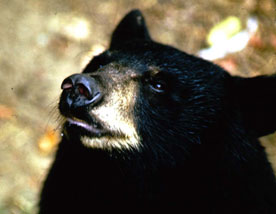Cooperative Black Bear Management Enhancement Activities of the South Carolina Department of Natural Resources

Hugh R. Still, Jr.1, Sam W. Stokes, Sr.1, Gary M. Peters2, and Mark S. Garner2.
1South Carolina Department of Natural Resources, 311 Natural Resources Drive, Clemson, SC 29631 and 2United States Department of Agriculture, Forest Service, 4931 Broad River Road, Columbia, SC 29212.
Abstract
There are two populations of American black bear (Ursus americanus) in South Carolina, one located in the mountainous region and the other in the northern coastal plain. The mountain population is located primarily in Oconee, Pickens and Greenville counties and the coastal population is primarily in Georgetown and Horry counties. South Carolina Department of Natural Resources (SCDNR) personnel have successfully cooperated with sportsmen groups, industry, universities, and other state and federal agencies to advance our knowledge base and improve bear habitat through cooperative research, habitat work, and management of black bear. Cooperative efforts have included hard and soft mast surveys, scent station surveys, trapping, DNA assessments and nuisance control. In addition, bear related legislation, co-sponsoring bear related meetings, wildlife management area litter collection, educational and nature related youth events, youth hunting opportunities and shrub plantings have been other activities. Data collected by non-agency cooperators has been very valuable with good consistency and no detectable bias. Overall benefits of the cooperative groups include the interaction of diverse groups, educational opportunities, information sharing, publicity, involvement, improved cooperation of agencies with the general public, increased employee morale, pooling of data, and additional opportunities for funding, manpower, and equipment. SCDNR acted as a leader in many of these activities and participated as a cooperator in others. Many individuals within these groups were knowledgeable of local fauna and flora. Cooperative projects satisfied their need to be actively associated with enhancing the black bear and generally aligned them with SCDNR. Partners also were more inclined to protect the resource they actively surveyed and managed. The cooperative groups have included the following: USDA Forest Service, Clemson University, The University of Tennessee, Georgia Department of Natural Resources, Tennessee Wildlife Resources Agency, North Carolina Conservation Commission, South Carolina Department of Parks, Recreation and Tourism, South Carolina Department of Transportation, Upper South Carolina Bear Hunters and Houndsmen Association, Oconee County Bearhunters, South Carolina Sporting Protection League, Duke Power Company, Crescent Resources, Fluor Daniel Company, Davis and Floyd Inc., Hobbs & Upchurch Company and local Boy Scout Troops. South Carolina is also a member of the Southern Appalachian Black Bear Study Group with Georgia, North Carolina and Tennessee. The activities of all these cooperators have greatly enhanced the public awareness and the habitats of black bear in South Carolina.
